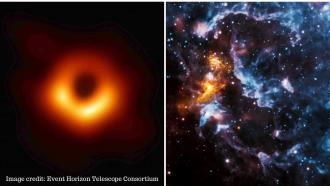![The first ever photograph of a black hole at the centre of M87 [Image credit: Event Horizon Telescope Consortium] The first ever photograph of a black hole at the centre of M87 [Image credit: Event Horizon Telescope Consortium]](/sites/researchmatters/files/styles/large_800w_scale/public/20190410-78m-4000x2330.jpg?itok=c5FtLt9w)
Haven’t we all heard about Black holes—those ‘monstrous’ structures in our Universe that swallow up everything within their reach, including light? Until now, how exactly a black hole looked has been a bit of a mystery, since no telescope had ever taken a picture of these gigantic structures, and their images were only limited by our creativity. Is a black hole, black and a hole? Although the image resembles this description—a ring of fire wrapping a dark central region—there's so much more to the story!
For the first time, scientists have revealed the first ever photograph of a supermassive black hole present at the heart of the distant galaxy Messier 87 in the Virgo constellation. The image, released today in a coordinated press conference held at six locations across the world, shows the shadow of a black hole. Its boundary, or the event horizon beyond which nothing can escape, is around 2.5 times smaller than the shadow it casts, and measures just under 40 billion km across. The snapped black hole is 55 million light-years from Earth and has a mass 6.5 billion times that of the Sun.
First predicted by Albert Einstein in his theory of general relativity more than a century ago, black holes are astronomical objects that can come in any size- from microscopic to the size of stars, packing enormous energy into a single point in space called the singularity.. The enormous size and relative proximity of M87 made it the perfect target for the scientists to conduct their experiment of photographing a black hole. The photo shows an amber coloured ring with light bent around the black hole due to its dense gravitational force. The ring is thicker at the bottom because there could be some matter that is rotating and surrounding the black hole, explained the scientists in the press conference.
The photo was clicked by the Event Horizon Telescope—a virtual earth-sized array of eight ground-based radio telescopes located at different parts of the planet by synced through atomic clocks. Observations collected from these telescopes were then processed simultaneously to stitch them together. This data was then processed in batches, like solving a jigsaw puzzle, to construct the image entirely. Overall, it was decades of hard work by an international collaboration of astronomers, observationalists, theorists and facilities from over 40 countries.
The telescopes contributing to this result were Atacama Large Millimetre/submillimetre Array (ALMA) and Atacama Pathfinder Experiment telescope (APEX) in Chile, the IRAM 30-meter telescope in Sierra Nevada, the James Clerk Maxwell Telescope in Hawaii, the Large Millimeter Telescope Alfonso Serrano in Mexico, the Submillimeter Array in Hawaii, the Submillimeter Telescope in the USA, and the South Pole Telescope in Antarctica. Supercomputers processed petabytes of raw data from these telescopes in the Max Planck Institute for Radio Astronomy, Germany and MIT Haystack Observatory, USA. The US National Science Foundation (NSF), the EU's European Research Council (ERC), and some agencies in East Asia funded the project. India was a part of The East Asian Observatory (EAO), which partnered with EHT.
In India, as part of the Indian Astronomical Observatory (IAO) located at Hanle, Ladakh, the Thirty Meter Telescope (TMT) will be housed. Once operational, TMT will be a general purpose telescope, exploring black holes, the birth and evolution of galaxies, stars and many more. Indeed, the future looks exciting with new instruments and global collaborations with cutting edge technologies aiding in making similar pathbreaking observations in the future.






